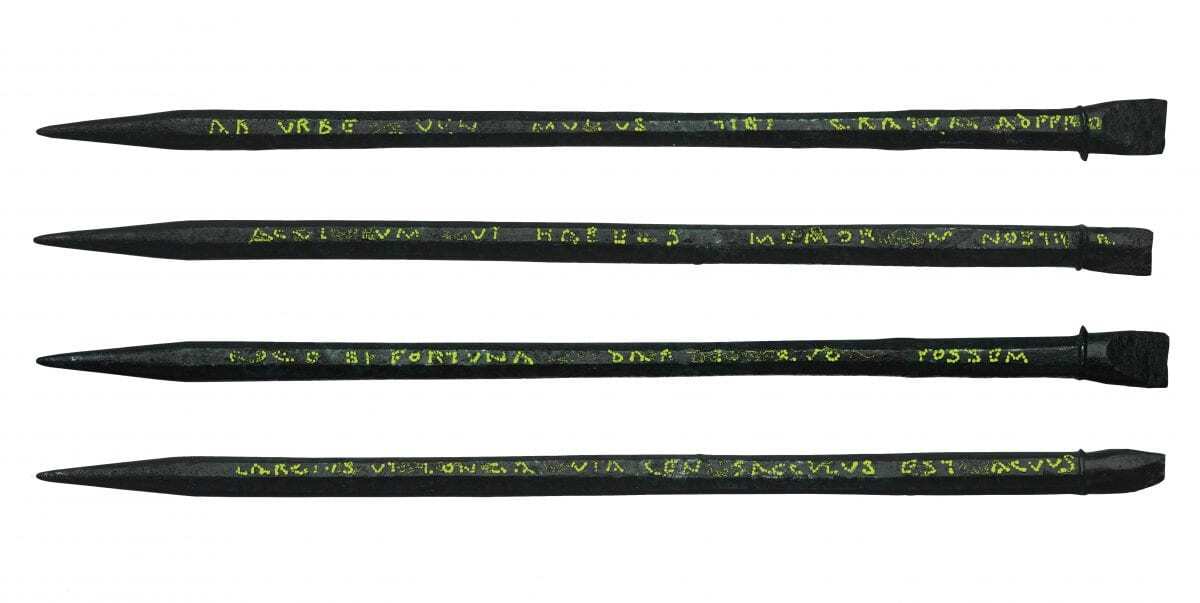A unique Roman stylus, with the most elaborate and expressive inscription of its kind, is set to go on display for the first time in a new exhibition at the Ashmolean: Last Supper in Pompeii.
It was discovered by MOLA archaeologists during excavations for financial technology and information company Bloomberg’s European headquarters in London, on the bank of the river Walbrook – a now lost tributary of the Thames. The iron stylus – used to write on wax-filled wooden writing tablets – dates to around AD 70, just a few decades after Roman London was founded.
The Bloomberg dig uncovered more than 14,000 artefacts revealing what life was like for the first Londoners, including the first written reference to the name of the city. 600 of the finds are now on display at London Mithraeum Bloomberg SPACE.
Of over 200 styluses recovered from the site, only one was found to have an inscription. Inscribed styluses are exceptionally rare: archaeologists have found only a handful of examples from across the whole Roman Empire to date, and the Bloomberg inscription is the finest, unparalleled in the length, poetry and humour of its inscription.
The inscription has been painstakingly examined and translated by classicist and epigrapher Dr Roger Tomlin. It reads:
‘ab urbe v[e]n[i] munus tibi gratum adf(e)ro acul[eat]um ut habe[a]s memor[ia]m nostra(m) rogo si fortuna dar[e]t quo possem largius ut longa via ceu sacculus est (v)acuus’
‘I have come from the City. I bring you a welcome gift with a sharp point that you may remember me. I ask, if fortune allowed, that I might be able (to give) as generously as the way is long (and) as my purse is empty.’
In other words: the stylus is a gift to remind the recipient of its sender; the sender acknowledges that it is a cheap gift and wishes that they could have given more. Its tongue-in-cheek sentiment is reminiscent of the kinds of novelty souvenirs we still give today. It is the Roman equivalent of ‘I went to Rome and all I got you was this pen’, providing a touching personal insight into the humour of someone who lived nearly 2000 years ago.

The letters of the inscription are tiny and exceptionally difficult to read, and their survival reflects both the excellent preservation of the Roman artefacts from Bloomberg and the careful work of MOLA’s conservators. It is possible that similar inscriptions on other Roman styluses have simply not survived or been identified.
The inscription even contains spelling errors from which it is possible to get a sense of the scribe’s train of thought. The final –m in nostram, for instance, has been missed off where they appear to have run out of space.
As ‘the City’ referred to is very likely Rome, the stylus suggests a direct link between Roman Italy and the province of Britannia. At this time Londinium lay near the edge of the Empire but, far from a being a provincial backwater, it had grown into an important centre for commerce and governance, interconnected with the wider Roman world.
The stylus and its inscription highlights the crucial role that writing and literacy played in allowing traders, soldiers and officials to keep in contact with peers, friends and family, some of whom lived over a thousand miles away.
MOLA Senior Roman Finds Specialist Michael Marshall said: “Research into the Roman artefacts from Bloomberg continues to uncover exciting information. This unique inscribed stylus provides a new window on Londinium’s international connections and its literary culture, but it also provides us with very tangible human connection to the owner and to the person who gave them this affectionate, if inexpensive, gift.”
Pliny the Elder’s favourite wine: inscribed barrel lid naming prized grape variety also going on display
Another fascinating object found by MOLA archaeologists during their excavations at Bloomberg is also set to go on display for the first time in the Ashmolean exhibition: a wine barrel lid. Its inscription sheds light on what the barrel’s contents once were, where it came from, and even who may have made it.

The first word of the inscription – AMIN – reveals that the barrel once contained wine made from Amineum, the finest grape variety available according to Pliny the Elder, which was also used in the famous Falernian wine from the Bay of Naples. This is believed to have packed quite a punch, with an alcohol content of 16%, and was aged for 15–20 years before drinking.
The lid’s inscription also names the origin of its contents – MASSIL, short for Massil(itanum), the Roman name for Marseilles – and the names of two people: Cornelius, who probably made or shipped this wine from Provence, and Messor, who may have made the barrel.
Last Supper in Pompeii: A major exhibition telling the story of the ancient Roman city of Pompeii’s love affair with food and wine
Opening on the 25 July 2019 at the Ashmolean in Oxford, Last Supper in Pompeii is a chance to see over 400 rare objects, including fine masterpieces of Roman art which range from the luxury furnishings of Roman dining rooms to the carbonised food that was on the table when Mount Vesuvius erupted.
Everything from the exquisite mosaics and frescoes in the villas of the wealthy to the remains found in kitchen drains, show what the Pompeiians loved to eat and drink. This remarkable exhibition reveals extraordinary details of their everyday lives. Further details can be found on the Ashmolean website.
Header Image – A unique inscribed Roman stylus uncovered by MOLA archaeologists during excavations for Bloomberg’s European headquarters in London. The inscription has been highlighted in yellow (c) MOLA.jpg





